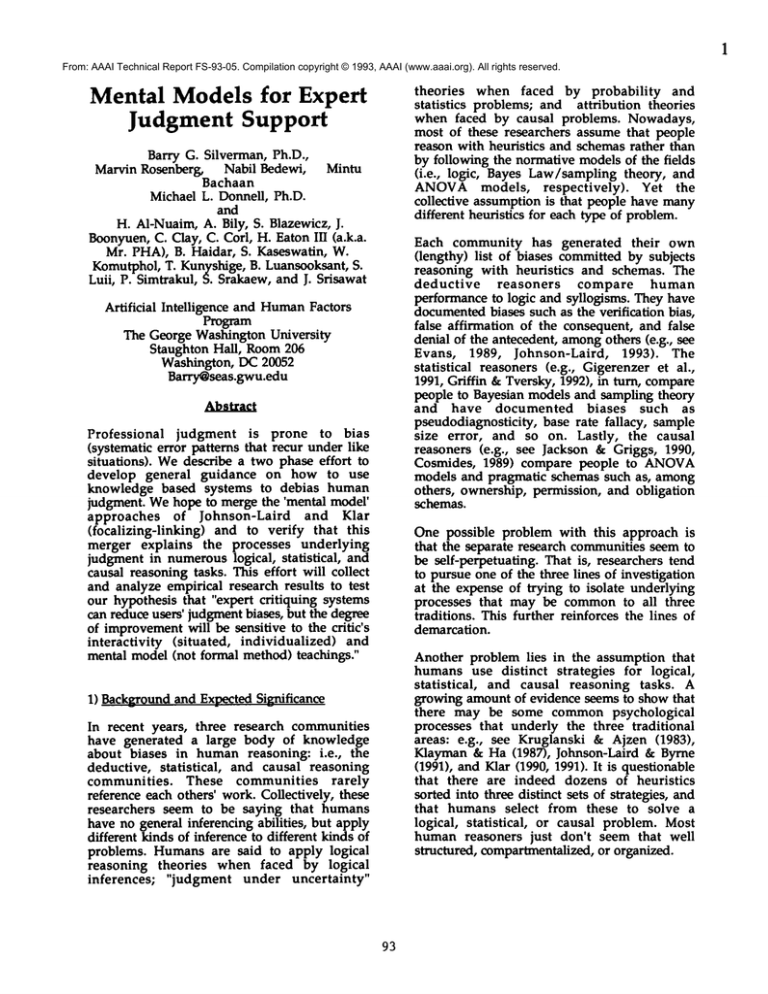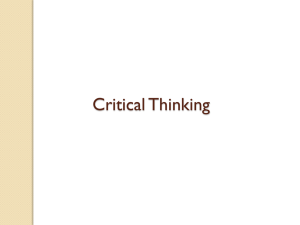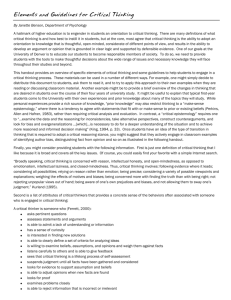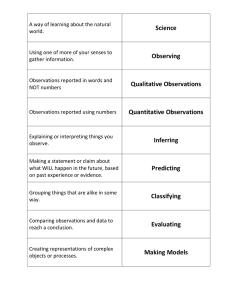
From: AAAI Technical Report FS-93-05. Compilation copyright © 1993, AAAI (www.aaai.org). All rights reserved.
theories
when faced by probability
and
statistics
problems; and attribution theories
when faced by causal problems. Nowadays,
most of these researchers assume that people
reason with heuristics and schemas rather than
by following the normative models of the fields
(i.e., logic, Bayes Law/sampling theory, and
ANOVAmodels, respectively).
Yet the
collective assumption is that people have many
different heuristics for each type of problem.
Mental Models for Expert
Judgment Support
Barry G. Silverman, Ph.D.,
Mintu
Marvin Rosenberg, Nabil Bedewi,
Bachaan
Michael L. Donnell, Ph.D.
and
H. A1-Nuaim,A. Bily, S. Blazewicz, J.
Boonyuen,C. Clay, C. Corl, H. Eaton III (a.k.a.
Mr. PHA), B. Haidar, S. Kaseswatin, W.
Komutphol, T. Kunyshige, B. Luansooksant, S.
Luii, P. Simtrakul, S. Srakaew, and J. Srisawat
Artificial
Intelligence
Each community has generated their own
(lengthy) list of biases committed by subjects
reasoning with heuristics
and schemas. The
deductive
reasoners
compare human
performance to logic and syllogisms. They have
documentedbiases such as the verification bias,
false affirmation of the consequent, and false
denial of the antecedent, amongothers (e.g., see
Evans, 1989, Johnson-Laird,
1993). The
statistical reasoners (e.g., Gigerenzer et al.,
1991, Griffin & Tversky, 1992), in turn, compare
people to Bayesian models and sampling theory
and have documented
biases
such as
pseudodiagnosticity, base rate fallacy, sample
size error, and so on. Lastly, the causal
reasoners (e.g., see Jackson & Griggs, 1990,
Cosmides, 1989) compare people to ANOVA
models and pragmatic schemas such as, among
others, ownership, permission, and obligation
schemas.
and HumanFactors
Proem
The George Washington University
Staughton Hall, Room206
Washington, DC 20052
Barry@seas.gwu.edu
Abstract
Professional
judgment is prone to bias
(systematic error patterns that recur under like
situations). Wedescribe a two phase effort to
develop general guidance on how to use
knowledge based systems to debias human
judgment. Wehope to merge the ’mental model’
approaches
of Johnson-Laird
and Klar
(focalizing-linking)
and to verify that this
merger explains the processes underlying
judgment in numerous logical, statistical,
and
causal reasoning tasks. This effort will collect
and analyze empirical research results to test
our hypothesis that "expert critiquing systems
can reduce users’ judgment biases, but the degree
of improvementwill be sensitive to the critic’s
interactivity
(situated, individualized) and
mental model (not formal method) teachings."
One possible problem with this approach is
that the separate research communities seem to
be self-perpetuating. That is, researchers tend
to pursue one of the three lines of investigation
at the expense of trying to isolate underlying
processes that may be common to all three
traditions. This further reinforces the lines of
demarcation.
Another problem lies in the assumption that
humans use distinct strategies for logical,
statistical,
and causal reasoning tasks. A
growing amount of evidence seems to show that
there may be some common psychological
processes that underly the three traditional
areas: e.g., see Kruglanski & Ajzen (1983),
Klayman & Ha (1987), Johnson-Laird & Byrne
(1991), and Klar (1990, 1991). It is questionable
that there are indeed dozens of heuristics
sorted into three distinct sets of strategies, and
that humans select from these to solve a
logical, statistical,
or causal problem. Most
human reasoners just don’t seem that well
structured, compartmentalized, or organized.
1) Backgroundand Expected Significance
In recent years, three research communities
have generated a large body of knowledjge
about biases in human reasoning: i.e.,
the
deductive, statistical,
and causal reasoning
communities.
These communities rarely
reference each others’ work. Collectively, these
researchers
seem to be saying that humans
have no general inferencing abilities, but apply
different kinds of inference to different kinds of
problems. Humans are said to apply logical
reasoning theories when faced by logical
inferences;
"judgment under uncertainty"
93
2
A third problem is that the heuristics
uncovered by the various researchers in the
three camps always seem to be incomplete.
They seem incomplete in at least two respects:
(1) there always seem to be more heuristics
that haven’t been identified and labelled and
(2) the heuristics that are in the literature are
often underspecified and ill-defined.
As an
example of the first
point, "selective
perception" is a popular bias but it is also a
form of the confirmation bias. Howdifferent
are either of these from the verification bias?
from the expectancy bias? Might there also be
an "agreement bias" that is yet to be defined?
Or, the availability
bias seems to more
recently overlap problems such as vividness
bias, ease of recall, wrongmodel retrieval, and
recency/primalcy, amongothers. As an example
of the second point, Klayman & Ha (1987)
dispell the myth of a single "confirmation
bias" and introduce concepts such as positivity
tests, negativity tests, and so on. They also
discuss various times when the confirmation
strategy is no bias at all. In a similar vein,
how long (minutes? hours?) and hard must
reasoner have sought information before being
guilty of "availability bias"? In short, most of
the heuristical biases seem to a morass of nonoperational terms. One cannot develop computer
programs to even recognize these biases, let
alone debias the human partner,
if the
judgment researchers themselves have yet to
develop operational definitions.
All of these problems could be alleviated by
the development of a well-defined model of the
psychological processes of human reasoning
underlying the three traditional camps. Such a
model could help cut past the lines of
demarcation, the proliferation of heuristics,
and the incompleteness issues. The underlying
process model we hope to construct and test here
is a merger and extension of the work of two
current researchers: Klar (1991) and JohnsonLaird (1993).
Once this model is developed and verified, we
believe it will provide a rigorous basis for the
design and implementation of interactive
programs that identify and debias errors in
judgment.
Such debiasing
programs are
desirable since they could be embedded and
triggered in a situated context. Humantraining
for debiasing purposes is fraught historically
with failure. Webelieve this failure is due to
the transfer problem, a problem that can be
minimized by situated, computerized "tutors
and critics". Since one usually can’t situate a
human tutor (on 24 hour call),
serves as a substitute.
the computer
In summary, our research involves a series of
experiments that both (1) define and verify
model of the processes underlying judgment bias
in human subjects and (2) attempt different
knowledge based strategies for training and
critiquing human subjects to improve their
performance. The goal of these experiments is
to isolate computer implementableexpert critics
that can be reused in multiple domains,
wherever the relevant (hypothesis testing)
biases arise. A second purpose is to illustrate
the steps needed to translate the cognitive
research results into useful guidance for
knowledge based systems designers. A final
purpose is to offer a knowledge based approach
as an alternative to the linear model debiasing
aids so popular in the behavioral decision
sciences.
2) Review of The Underlying Process Model
The introduction stated that a useful model of
the processes underlying judgment could be
formed by merging and extending the work of
Klar (1991) and Johnson-Laird (1993). Due to
broad applicability,
we wished to adopt
Johnson-Laird’s
overall framework and his
ideas that reasoners form partial visual models
of the domain. However, that model is too
general for our purposes. Conversely, Klar’s
focalizing-linking model is appealing for its
specificity. Yet it leaves too many unanswered
questions about its stages and how people
actually use it. The merger of these two models,
with minor extensions, leads to a two stage
model as follows (see Figure 1).
In stage 1, knowledgeis acquired according to
Klar’s model. Here the subject reduces a
problem to focal categories (typically x and y,
or y, if x then y, etc.) and studies data in the
domainto assess the degree of certainty in the
two links (x-y and y-x) between the foci. For
example, "all psychologists (x) are skeptics
(y)" suggests a FULLlink from x to y. Since all
skeptics (y) aren’t psychologists (x), there
only a PARTIAL
link from y to x. Thus the x-y
focal categories for this example embody a
FULL-PARTIAL
link structure.
The x-y categories and links maybe represented
in terms of Venn diagrams. In a Venn diagram
sense, if y is a superset of x (e.g., skeptics is
superset of psychologists), then the x-y link is
%
Ul
U"
u.
l.
tJ
0
I--
~Z
Z
I- I"I.i.
.¢
I-- ’
ZI-
N
I!
-J
~j N r’?
_~t.Ia
(.
°
.i _ o
u.
I-Z
W
C21,~ ’-"
Z
,==~,.~
,--I
I--
Z
x{
x
Z
0.
n II
>
LI
_j
ILl
tn
-- wZ
~) ~.~
--
I’Z
Z
95
3
FULL,but the y-x link is PARTIAL.If x and y
completely overlap (their union = their
intersection), then the link structure is FULLFULL.This would be the case if there were no
other skeptics
in the world. If x and y
artially overlap then both the x-y and y-x
nks are PARTIAL
(e.g., If some psychologists
were not skeptics, then the structure would be
PARTIAL-PARTIAL). In this fashion,
the
subject works through the focalizing and linking
steps of the model (Figure la). Since there are
usually more than just two categories in a given
domain, the output of this stage is only a
partial mental model of the domain.
~i
In stage 2, knowledge is applied according to
Johnson-Laird’s model. Whena problem arises,
the subject associates the relevant, partial
mental model and applies it to form an initial
judgment(see step 2.1). A validation step ensues
in which the subject attempts to falsify his/her
initial judgment. If step 2.2 is unsuccessful, the
subject feels the judgment is valid (to some
degree of confidence).
Consider an example where a reasoner knows
two pieces of data: (1) A party had only joggers
and basketball players in attendance. (2) Some
people at the party were members of the
Hickory Club.
Figure 2 shows a Venn diagram that I have in
mind as the full model of this data. Most
subjects won’t construct this model. They would
construct a partial model as appropriate to
their interpretation of the data and relevant to
the problem they’re asked to solve such as: "If
you met a Hickory Club memberat the party,
how likely is he to be a jogger?" In this
instance the reasoner forms a partial mental
model of Figure 2. We can’t say exactly what
this model would look like in the subject’s
mind, but it might contain: x = Hickory Club, y
= joggers, x-y link = PARTIAL(i.e.,
some
Hickory Club membersare joggers), and y-x link
= PARTIAL(i.e.,
some joggers belong to the
Hickory Club). Using this model, the subject’s
answer, after attempting (and failing) to prove
it false, would be: "Only partially probable."
This example illustrates
many of the features
discussed earlier. It suggests that subjects avoid
both normative models (e.g., probability and
statistics) and compartmentalized, superficial
heuristics.
The latter point holds because
subjects apply the same focalizing-linking
models to all three of the traditional forms of
reasoning. For example, consider the common
error categories of these traditional campssuch
96
as listed down the second column of Figure 3.
The first three of these errors are often
investigated
by the statistical
judgment
community, while the last three errors are
commonly studied in the logic reasoning
community.The last error is also the subject of
much examination
in causal
reasoning
psychology. The third column of Figure 3 uses
the jogger-basketball party of Figure 2 as a
source of examples of the judgment biases.
Finally, the right hand column illustrates how
the focalizing-linking process can describe all
these different biases.
In the first task of Figure 3, subjects are asked
to form hypotheses from sampling data.
Insensitivity to sample size suggests reasoners
prematurely form hypotheses from insufficient
data (e.g., that all membersare joggers after
seeing only 5 % of the data). In Klarian terms,
this implies subjects
assess the links
prematurely (or they forget partial links in
favor of full linkages). In the second task,
subjects are asked to form hypotheses in the
presence of statistical information, while in the
third task they must decide what questions to
ask when diagnosing hypotheses. In both tasks
subjects overlook statistical information, and
replace it with simple heuristics
(e.g.,
representativeness is used instead of base rate
probabilities or instead of the denominator of
the likelihood ratio). Klar’s experiments show
that subjects’
judgments more closely
approximate judgments formed with statistical
models (e.g., use of base rate and likelihood
ratio denominators) when they believe the
focal categories
have a PARTIAL-PARTIAL
linking structure. The subjects do not use the
equations and statistics,
but their judgments
reflect the uncertainties,
especially
as
compared to subjects with FULL-FULL
models.
Consider next the deductive tasks of the fourth
and fifth rows of Figure 3. If given a logic
statement of the form "If x, then y", subjects are
shown to be poor at forming and processing
truth tables to test the x hypothesis in the
presence of various facts about the world. When
given the fact "y" they assume x must have
been true. Alternatively, when given the fact
"not-y", they falsely assume the rule implies
not-x is true. Neither of these deductions can be
reached from a correctly processed truth table.
Yet our mental model approach suggests that
people do not set up and process truth tables
(just as they don’t use statistics equations).
Instead they build the simple focal category
models out of the x-y items. They errors of the
Fiaure 3 - Common
Examnles
of Error in Focalizina & Lipkinn_
Forming
Hypotheses
WithStatlml¢~
Bmm
P, ate
Fallacy
Sublm:t= neglemto "~ %
of joggersal pity p(H)
Deciding
Questions
Relevantto
a Diagnosis
Psludodllgnoellcfly
Whim
~ ~ ¯
~ Of a ~ (=O)
beingI jogger(=H),
Suble~l ~ to inqul~
al=oultire %o( Imilmlmll
pmyemvmom
m
rmmmem
I=(Olmt H)
(Le., dmmmmmr
ot
I~ ralm)
Deducing
tne Truth of an
Hypothesis
(IF..clauSml
Afflrlrnallonof
the Conlequmm
Ru~:"If youlog, III
Inv#eymlto loin tire ¢~ub."
Sublmms
thi~ tim the
~ ill Ileo Implkld:
If I Inv~ yoato joln tlm
clul=,thenlYaUIOli."
Oeaucing
the Truthof an
Hypothesm
(Negation)
=’= of the
Den
A~
Give: SameIF-THENrole
~Jl:l~ll¢~llUtllllk
UIMtlte
~ bl al~ Impied:
"ff youdollOt Ji~in ttI c~,
youda~tfell."
Testing
Initial
Hypotheses
VerilcaUon
BIll
G/vlil1: ~ iF,.11.IEN rum
~ ~ iglliOl11~
~ 11101*Y
mm-- =m~l non-loggem
If they IXmnli to meQlm.
Sire}acts uu
repmsenlallvenm=
of O calegmry
to H ¢=mgowy
(Theyi=o mmmr
i/
tlmr
~ ~ I#
parllal-pal’U81).
In merule:
X--lair-aideIo~
Y=rlghl-mde
S,~,ject# mlmNamly
"~ a#mu,me
Io~ rare
FULL.FULL
llnkU,
lrl.,~¯
TABLE I - SUMMARY
OF RESULTSACROSSGROUPS
EXPERIMENTALGROUPS
FRIES PER TASK:
:OMMUNITY CENTER
1ST TRY
I
RESTRUCTURED
TASK
l.Human
Tutor,
2
3
4
~
?
Formal
Formal Mental Mental Formal Mental Mental
Method Method Model Model Method Model Model
63%
2NO TRY
33%
0%
20%
33%
50%
0%
B0X
83%
0%
50%
20% ? 90%
67%
83% 90% 100%
60% 100%
NA
NA
83%
2ND TRY
3RD TRY
NA
100%
NA
100%
17%
80%
100%
20%
90%
100%
17%
100%
100%
20%
100%
3RD TRY
100%
83%
100%
100%
40%
100%
4TH TRY
NA
NA
100%
NA
6
6
4TH TRY
PLANET VUMA TASK
1ST TRY
UMBE~OF SUBJECTS
IN EACH GROUP
NA - Not Applicable
16
97
10
6
100% NA
5
I0
4
4th and 5th rows of Figure 3 can be accounted
for if we presume that subjects
mistakenly
assume FULL-FULLlinks between the x and y.
This in turn leads them to false conclusions
(about the antecedent
or consequent)
when
applying the statement to data. The last row of
Figure 3 applies to causal as well as logical
reasoning (e.g., as in Wason (1960)’s selection
task). Again subjects probably fail the task due
to improper focalizing-linking,
rather than to
truth table (or statistical)
errors. The reader
referred to Klar (1991) or to Johnson-Laird
Byrne (1991) for further background on this.
3) Implications for Expert Critics
Klar gives little
by way of suggestions
for
debiasing (one paragraph in Klar, 1990), except
to state it is not necessary to train people to
think like trained statisticians
or logicians.
It is more important to assure they are aware
of the proper foci and links,
and how data
explain these items. He suggests it is important
to help people focus beyond the explicit,
to
avoid inflating partial into full links.
Following this idea, this section extracts
guidance for debiasing
aids. The extracted
guidance
should
provide
a map each
critic/tutor
screen can point back to. The
guidance is organized by stage and step of the
model (of Figure 1), and by higher level metaconcerns as follows:
Common
Critiquing and Tutoring Methodsfor Stage I:
Critique focal operations
Assureproperfoci are in the mentalmodel
(visual diagram)
Argueover phrasingsof the focal hypotheses
(e.g., point out whereoneshouldattach qualifiers
such as
NOT, SOME,MOST,etc.)
Drawattention to evidencerelated to
altemativefocal categories
Point out info to discernfocal categories
fromtheir alternatives
Critique/Argueaboutlink relations
Showhowthe data supports an altemate
juxtapositionin the visual diagram
Insert PARTIAL
instead of FULL(or vice
versa)wordingin a textual description)
SupportMentalModelManagement
for StageI1:
Store mentalmodels
Retrieveappropriatementalmodel,Argue
againstinappropriate
Adaptmentalmodelto newsituation (update
foci andlinks)
Reinvokeanyof the StageI critics
98
Meta-Level
Critics that coverdebiasingstrategies #s 3
and4 mentioned
at the end of Section3.4.1 :
Restructure the Problem
Change
the textual form of the problem
statement(e.g., replace IF with IF ANDONLY
IF)
Change
the visual form of the problem
statement(e.g., display it as a Venndiagram,Euler
circles, etc.)
Alter the task (e.g., addinstructions, reduce
choices,alter focus)
ContentFamiliarization
Point out similarities of currentproblem
to a
familar one(argueaboutdissimilarities)
Askuser to solve a similar (familar cframe
problemand help themmapthat solution to
current problem
Generatedefault answers
with rationales for
whythey apply
Tutor andtell stories aboutunfamiliar domain
(insert artificial experience
base)
One can readily see that this list conforms to
the stages and steps of the model of Figure 1,
and it accounts for many categories of debiasing
mentioned in the literature.
Also, as Klar
recommends, these methods do not train the
subjects in statistics,
logic, etc. Instead, they
help people focus beyond the specific, and they
help subjects create and use appropriate focal
categories and links.
4) Desii~mof E _xperiments
The purpose of the experiments is primarily to
test two ideas: (1) that mental model training
is effective in reducing judgment bias, and (2)
that computerized critics and tutors outperform
the (lecture-based)
human training approach
debiasing if they are interactively
situated in
the work environment. To date, we ran a control
group plus 6 experimental
groups.
Each
experimental group investigates the impact of a
different set of training or other interventions
upon judgment bias.
Group I will implement a lecture-based training
scenario, and all human lecturing will present
the formal theories relevant to the task. The
six non-lecture groups will be exposed to diverse
interventions
that will try to get them to
replace
their FULL-FULL links either
with
formal
methods or with improved mental
models (e.g.,
PARTIAL-PARTIAL).
The next three groups, Groups 2 through 4, are
intended to test the idea that subjects don’t
need to be trained statisticians,
logicians, or
causal reasoners to achieve robust performance.
Specifically,
Group 2 will implement
an
5
interactive training scenario, but all tutoring
will present the formal theories relevant to the
task. In Group 3, the tutoring will avoid this
material and focus on the underlying mental
model as originally discussed. For both groups,
the subjects will receive a critique of their
problem 1 performance, before attempting
problem 2 (they won’t proceed until they get at
least three tries to get the 1st problem right).
Group 4 will be identical to Group 3 except it
will include training
in the use of Venn
diagrams (in the context of a separate problem)
before the users see problem 1. By comparing
Group4 to Group 3 results we hope to learn how
readily subjects understand Venndiagrams, and
from that to infer if Venn diagrams are a
naturalistic representation. By comparing Group
2 and 3/4 results,
we should be able to
determine if mental model training is as good
as formal method training. Results of Groups 2
also can be compared to the humanlecturing of
Group 1 to see if interactive training is more
effective than human lecturing of the same
material.
who succeeded by the end of a given try. To
facilitate
comparisons across groups, the
numbers are the percent of total sample that
succc~cled up to and including that try. The
last row gives the sample size of each group.
The non-computerized training test involved a
20 minute lecture on formal methods, judgment
bias, and examples after which the subjects
were given 1 try at problem 1.
6) Discussion of Results
The data in Table 1 support the idea that
interactive training outperforms lecturing, even
when the former is automated and the latter is
delivered by a human.Specifically, the lecture
group, Group 1, was only given one try. Table 1
shows that 10 subjects out of 16, or 63%of the
sample got the right answer on the first try.
This score reflects the impact of the lecture.
The remaining six groups were given three (and
sometimes four) tries on each problem. Their
first try is prior to any intervention, while
subsequent tries were preceeded by computer
critiquing. Bytheir last try on each problem, at
least 66% and usually 100%of the members of
each group got the right answer. Except for the
66% case, the relative
improvements are
statistically
significant,
and debriefing
comments indicate the debiasers (rather than
lucky guessing) helped.
The last three groups are intended to test the
impact of task restructuring. Johnson-Laird and
others stress
the importance
of small
rephrasings of the task that reduce the number
of mental model manipulations expected of the
subject. We are curious as to whether these
rephrasings don’t also help under the formal
approach to training. For example, does the
restructuring of the problem statement have an
impact whether formal or mental models are
used? Groups 5, 6 and 7 are identical to Groups
2, 3, and 4, respectively, except for the task
rephrasings.
The data in Table 1 also generally support the
idea that mental model training is just as
effective as formal method training. Comparing
between the first three interactive groups, we
see that mental model training for Group 4 was
at least as effective as formal method training
for Group 2. That Group 3 did worse implies
that users are not initially comfortable with
Venn diagram representations.
This same
overall performance pattern was repeated for
Groups 5, 6, and 7. In short, the mental model
training hypothesis can be supported, but only
if subjects are first familiarized with the
mental model representation being used. One
must wonder if there is not a mental model
representation so natural that familiarization
is unnecessary.
5) Results
The tests consisted of 6 experiments designed by
the lead author with the help of three
doctoral students,
and run by 4 teams of
graduate students (last 16 co-authors) as
classroom project. Also, prior to these tests, the
lead author performed a non-computerized,
lecture-based training experiment on the 4
teams of graduate students as the Group 1
experiment.
A surprising result of the experiment is that
problem restructuring (Groups 5-7 relative to
Groups 2-4) fails to impact task performance.
Johnson-Laird’s prediction is that reducing the
number of mental model manipulations (e.g.,
via restructuring) should reduce the error rate.
It is too early to drawany conclusions, since the
Table 1 summarizeshigh level results across all
groups. The columns of Table 3 correspond to
experimental groups. The rows of Table 1 show
the # of tries to get each of the problem 1 and 2
questions correct. The numbers in the body of
the table are the cumulative number of subjects
99
6
sample sizes are small, the experiment only
looked at one of the six tasks, and there maybe
improved ways to restructure the problem. We
hope to look into this more fully in subsequent
investigations.
Finally¯ the data also generally support the
idea that interactive, context sensitive critics
help subjects overcomethe transfer problem. For
all groups, except Groups 4 and 7, the transfer
was successful. Excluding these two outliers,
subjects got the correct relevancy answer on the
first try from between 20 to 50%. This rose for
the first try on problem 2 to between 80 to 100%
across problems. This improvement properly can
be attributed to the computerized critics. The
Group4 and 7 outliers are chocked up to lack of
Venn diagram familiarity.
Evans, J.S.B.T.,
Bias in Human Reasoning:
Causes and Consequences¯ Hillsdale:
L.
Erlbaum, 1989.
Gigerenzer, G. et al., "Probabilistic Mental
Models: A Brunswikian Theory of Confidence,"
Psych Review,v. 98, n. 4, 1991, pp. 506-528.
Griffin, D., Tversky, A., "The Weighing of
Evidence
and the Determinanats
of
Confidence", Cognitive Psychology, v. 24¯ 1992,
pp. 411-435.
Jackson, S.L., Griggs, R.A., "The Elusive
Pragmatic
Reasoning
Schemas Effect,"
Ouarterly I. of Experimental Psychology, v.
42A¯1990, pp. 353-73.
Johnson-Laird, Human and Machine Thinking,
HiUsdale: L. Erlbaum, 1993.
7) Concluding Remarks and Next Steps
Professionals tend to commitbiases, patterns of
error they are unaware of yet repeatedly
commit under like situations. The goal of this
research is to find ways for the computer to
cooperate with professionals
to improve
judgment (reduce bias). Wetheorized a mental
model-based approach that could serve as the
foundations
for such a human-computer
cooperation. This approach lead us to a number
of predictions of why error occurs and how to
eliminate it. The pilot experiment supports the
mental model approach and the predictions of
this paper. In particular,
the data does not
negate our hypothesis that "expert critiquing
systems can reduce users’ judgment biases, but
the degree of improvement will be sensitive to
the critic’s
interactivity
(situated,
individualized) and mental model (not formal
method) teachings."
Johnson-Laird, P.N., Byrne, R., Deduction.
HiUsdale: L. Erlbaum, 1991.
Klar, Y., "Logical, Statistical,
and Causal
Reasoning: Compartmentalized
or Generic
Processes?",
European Review of SQcial
v.2, 1991, pp. 127-136.
¯ "Linking Structure and Sensitivity to
Judgment-Relevant Information in Statistical
and Logical Reasoning Tasks," ]. of Personality
and Social Psychology. v.59, n. 5, 1990, pp. 84158.
Klayman, J., Ha, Y-W, "Confirmation,
Disconfirmation, and Information in Hypothesis
Testing," Psycholo~cal Review, v.94, n.2, 1987,
pp. 211-28.
ACKNOWLEDGEMENT
Kruglanski, A.W., Ajzen, I., "Bias and Error in
Human Judgment," European |. of Social
Psychology.v. 13, 1983, pp. 1-44.
The partial support of NASA/GSFC/Code500
is gratefully acknowledged. Any positions,
opinions¯ data, or errors are those of the
authors alone, and do not represent official
governmentpositions.
Silverman, B.G.,"Critiquing
HumanJudgment
With Knowledge Acquisition Systems," A I
Magazine.v.11, n.3, Fall 1990, pp. 60-79.
, "Modeling and Critiquing the
Confirmation Bias in HumanReasoning," IEEE
Transactions on Systems, Manand Cybernetics,
v.22, n.5, Sep/Oct 1992d,pp. 973-83.
REFERENCES
Cosmides, L., ’The Logic of Social Exchange:
Has Natural Selection Shaped How Humans
Reason?"¯CoeTlition, v.31, 1989, pp. 187-276.
i00
Wason, P.C., "On the Failure to Eliminate
Hypotheses in a Conceptual Task," Ouarterly |.
Experimental Psychology, v.12, pp. 129-40, 1960.




